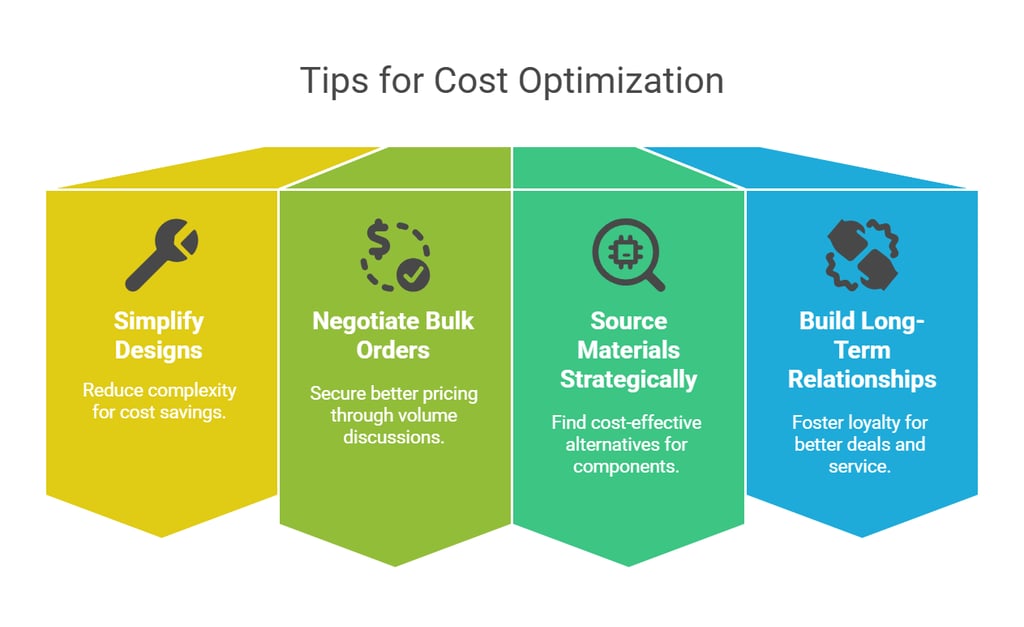Mastering Electronics Manufacturing Quotes: A Designer’s Guide to Cost Optimization and Decision-Making
Understanding the electronics manufacturing quotes isn’t just about crunching numbers—it’s about making informed choices that save time, money, and headaches. Whether you’re a hardware startup founder or an engineering lead at a big firm, this guide is for you.
3/3/20256 min read


Imagine you’ve just poured months into designing the perfect circuit board for a sleek new wearable gadget. You’re buzzing with excitement, ready to see it come to life—until you get a manufacturing quote that’s double your budget. Sound familiar? If you’re a designer or decision-maker in electronics development, you’ve probably felt that gut punch at least once. Electronics manufacturing quotes aren’t just numbers on a page; they’re the bridge between your brilliant ideas and a tangible product hitting the market.
Understanding these quotes isn’t just about crunching numbers—it’s about making informed choices that save time, money, and headaches. Whether you’re a hardware startup founder or an engineering lead at a big firm, this guide is for you. We’ll walk through what these quotes mean, why they matter, and how you can master them to bring your vision to life without breaking the bank.
II. What Are Electronics Manufacturing Quotes?
Let’s start with the basics. An electronics manufacturing quote is like a roadmap—it’s the manufacturer’s estimate of what it’ll cost to turn your design files into a finished product. Think of it as a handshake agreement: “Here’s what we’ll charge to build your PCB, assemble your components, and get it out the door.”
A typical quote breaks down into a few key pieces:
Material Costs: The price of resistors, capacitors, ICs—everything listed in your Bill of Materials (BOM).
Labor Costs: The human effort to solder, assemble, and test your product.
Overhead and Tooling: The hidden stuff like machine setup, factory rent, or custom jigs for your design.
Profit Margin: Because, let’s be real, manufacturers aren’t charities.
Quotes might come as a per-unit cost, a total project fee, or even tiered pricing based on volume. For designers, this is your first glimpse into how feasible your project is—and where you might need to tweak things.
III. Why Electronics Manufacturing Quotes Matter
Picture this: You’re pitching your prototype to investors, and someone asks, “How much to produce 10,000 units?” If you don’t have a solid grip on manufacturing quotes, you’re stuck guessing—and that’s a fast way to lose credibility. Here’s why these quotes are your secret weapon:
Budget Planning: A good quote helps you map out cash flow, whether you’re bootstrapping or backed by VC funds.
Comparing Vendors: Quotes let you pit manufacturers against each other to find the best fit for quality and price.
Avoiding Hidden Costs: Ever been blindsided by a “small” shipping fee that wasn’t so small? A detailed quote keeps those surprises at bay.
For decision-makers, quotes are your compass. They guide you toward vendors who align with your timeline, quality standards, and bottom line.
IV. Factors That Influence Electronics Manufacturing Quotes
So, why does one quote come in at $5 per unit and another at $15? It’s not random—several factors are at play. Let’s break them down:
Design Complexity: A single-layer PCB for a simple LED toy costs pennies compared to a multilayer board for a 5G router. More layers, tighter tolerances, and exotic components? Expect the price to climb.
Volume of Production: This is where economies of scale kick in. Ordering 100 units might cost $10 each, but 10,000 could drop to $3. Manufacturers spread setup costs thinner with bigger runs.
Materials Used: Gold-plated connectors sound fancy, but they’ll jack up your BOM costs compared to copper. Even lead-free solder (for RoHS compliance) adds a few cents per unit.
Location of Manufacturer: A U.S.-based shop might charge more for labor but deliver faster, while an offshore plant in Asia could save you 30%—if you’re okay with longer lead times.
Lead Time: Need it yesterday? Rush orders mean overtime pay and expedited shipping, which inflate quotes fast.
Certifications and Compliance: If your product needs UL certification or meets strict environmental standards, manufacturers bake those testing costs into the price.
As a designer, every choice you make—down to the width of a trace—ripples into that final number. Decision-makers, meanwhile, weigh these trade-offs against market demands and deadlines.
V. How to Request and Evaluate Electronics Manufacturing Quotes
Getting a quote isn’t just emailing a manufacturer and crossing your fingers. It’s a process—and doing it right can save you thousands. Here’s how:
Preparing Your Request: Be thorough. Send your BOM, Gerber files, and assembly drawings. Spell out your volume (e.g., 500 units) and timeline (e.g., 8 weeks). Vague specs lead to vague quotes—and wasted time.
Questions to Ask Manufacturers:
“Are setup fees included, or separate?”
“Can you break down material vs. labor costs?”
“What’s your minimum order quantity (MOQ)?”
Comparing Quotes: Don’t just pick the cheapest. Normalize the numbers—divide total costs by units if one vendor quotes per piece and another doesn’t. Check what’s included: testing, packaging, shipping. A lowball quote might skip quality checks you can’t afford to miss.
I once worked with a designer who got burned by a “bargain” quote that left out functional testing. Half the batch failed in the field—costly lesson learned. Take your time here; it’s worth it.
VI. Tips to Optimize Your Electronics Manufacturing Quotes
Here’s the fun part: slashing costs without compromising your vision. These tricks come from years of tinkering and talking shop with industry folks:
Simplify Designs: Can that 6-layer PCB work as a 4-layer? Fewer layers mean less drilling and lamination—cha-ching, savings. Use standard component sizes (e.g., 0805 resistors) to avoid pricey custom sourcing.
Negotiate Bulk Orders: Even if you don’t need 10,000 units now, ask for tiered pricing. Manufacturers might cut you a deal knowing you’ll scale up later.
Source Materials Strategically: Chat with your vendor about alternatives. Maybe a slightly cheaper capacitor still meets spec. I’ve seen teams save 15% just by swapping out overkill parts.
Build Long-Term Relationships: Stick with a reliable manufacturer, and they’ll often throw in perks—lower rates, faster turnarounds. Loyalty pays off.
One startup I know shaved $2 per unit off their quote by tweaking a resistor layout. Small moves, big wins.


VII. Common Pitfalls to Avoid
We’ve all been there—seduced by a shiny low quote only to regret it later. Watch out for these traps:
Ignoring Fine Print: A $4/unit quote sounds great until you see the $2,000 shipping fee buried in the terms. Read every line.
Overlooking Quality: Cheap quotes sometimes mean cheap shortcuts—skipped tests, subpar components. Your reputation’s on the line; don’t risk it.
Unrealistic Expectations: If a quote seems too good to be true, it probably is. A vendor promising 1,000 units in a week for peanuts might be cutting corners—or flat-out lying.
I’ve seen decision-makers push for the lowest bid, only to scramble when prototypes failed QA. Balance cost and quality—it’s not just about today’s budget but tomorrow’s success.
VIII. Real-World Examples
Let’s ground this in reality with a couple of stories:
Case Study 1: The Wearable Win: A startup designing a fitness tracker got quotes ranging from $8 to $20 per unit. By simplifying their enclosure and negotiating a 5,000-unit run, they locked in $6/unit with a U.S. vendor. Launched on time, under budget—investors were thrilled.
Case Study 2: PCB Pain to Profit: A team building IoT sensors faced a $12/unit quote for a complex board. They redesigned it from 8 layers to 6, swapped premium connectors for standard ones, and cut costs to $7/unit. Sales soared, proving smart design beats brute force spending.
These aren’t hypotheticals—they’re lessons from the trenches. You can do this too.
IX. Conclusion
Mastering electronics manufacturing quotes isn’t rocket science, but it does take savvy. For designers, it’s about crafting products that shine on paper and in production. For decision-makers, it’s about steering the ship toward profitability without sinking the budget. From decoding cost factors to dodging pitfalls, you’ve now got the tools to turn quotes into allies—not enemies.
Ready to take control? Start requesting quotes with confidence. Share this with your team, tweak your next design, and watch those numbers work in your favor. Your next big idea deserves it.
X. Additional Elements
FAQs
How long does it take to get a quote? Usually 1-5 days, depending on complexity and vendor workload.
What’s a typical MOQ? Often 100-1,000 units, but it varies—ask upfront.
